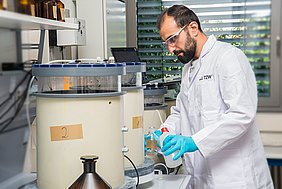Urease and nitrification inhibitors are frequently used in agricultural practice and, for example, as additives in liquid manure. In particular, urease inhibitors are expected to be used to a greater extent in the future due to new requirements of the German Fertiliser Ordinance (Düngeverordnung DüV 2017). TZW has investigated the substances used with regard to their as yet unknown environmental behaviour and the possibility of the translocation from soil to groundwater.
The research project "Opportunities and risks of nitrification and urease inhibitors for water protection" (INHIBIT) aimed at closing knowledge gaps on the environmental behaviour of nitrification and urease inhibitors. For this purpose, lab and field tests were being carried out within the project.
First, the substance-specific physico-chemical properties were evaluated by literature research (IWW) and by laboratory studies (TZW). The translocation behaviour of the inhibitors was subsequently investigated in lab-scale and field lysimeter experiments. In the field lysimeter the substances could infiltrate the soil under natural climatic and soil conditions. In the laboratory lysimeter, soils from various study sites were used and lysimeters were operated under controlled boundary conditions to investigate the environmental fate of nitrification and urease inhibitors.
At IWW, the available information on use and products was collected and the authorisations were read and analysed. In addition, the behaviour of the compounds during bank filtration was simulated at UBA, while IfÖL balanced the behaviour of the inhibitors on agricultural land and carried out field experiments.
Based on the results, the translocation behaviour of nitrification and urease inhibitors with the leachate was evaluated. The result provides information on how persistent the substances are in the soil and whether they can pose a risk to groundwater.
From the project results, recommendations for the evaluation and use of nitrification and urease inhibitors in practice have been derived. In doing so, the existing deficits in the regulatory environment became clear, e.g., the lack of a declaration requirement.

![[Translate to English:] Prüfstelle-Produktprüfung_Teststand Test centre and product testing](/fileadmin/_processed_/0/9/csm_TZW-Karlsruhe_Pruefung_Geraete-Teststand_377188946c.jpg)

























